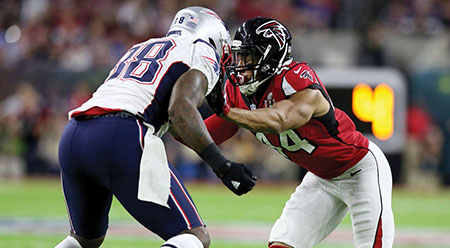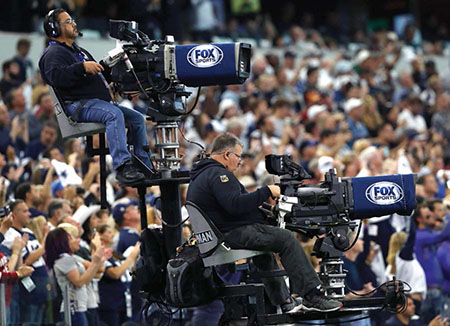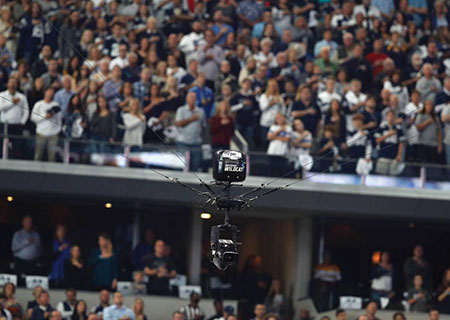Bringing Clarity to NFL Coverage
BALTIMORE—When the NFL introduced instant replay in the 1960s, just having the opportunity to get a second look at a certain play and an opportunity for confirmation was thought to be a giant leap for mankind, (in the sporting sense, anyway); no one imagined that one day, stop motion and a variety of angles would be a factor.

Atlanta Falcons Vic Beasley Jr., #44, in action against Martellus Bennett, of the New England Patriots at Super Bowl 51.
PHOTO CREDIT: AP Photo/Gregory Payan
However, they have, and to the point that most of the cameras on a football field can perform that function. Anyone who watched Super Bowl LI and saw the famous catch made near the game’s end by Julian Edelman of the New England Patriots—than confirmed, without question, that his fingers were not touching the ground when he somehow held on to a tipped pass.
That was also confirmation to the networks that what are known as “super-” and “hypermotion” cameras, like the Sony 4800 and 4300, will take on an even more important role in the 2017 NFL season.
HEIGHTENED DRAMA
One of the big things broadcasters have been looking at “is clarity in replays,” said Michael Davies, senior vice president of field operations for the NFL on Fox. “Football is a game where you get several chances to examine what happened on a given play in various ways and this new technology is allowing us to do that,” he said.
Super Bowl LI, which was presented by Fox Sports, is a case-in-point that gave viewers “the chance to see more replays in super motion and hyper motion than ever before,” Davies said, such as Edelman’s shoestring grab. “These types of replays were used on countless occasions during the game and helped us tell the story better and with more drama and emotion.”
He recalled points in previous Super Bowls where using super motion—from a variety of angles—provided important insights, such as toward the end of Super Bowl XLII, when David Tyree of the [New York] Giants made his famous ‘helmet’ catch. “We only had a couple of these cameras then; [that turned out to be] the iconic shot,” Davies said. “Now, we have many of these devices for such key plays, so the fan is seeing much more” than ever before.
Get the TV Tech Newsletter
The professional video industry's #1 source for news, trends and product and tech information. Sign up below.
This season, for Fox Sports’ “America’s Game of the Week,” on Sundays, the network will utilize a minimum of six Super Motion cameras. “Every year, it becomes possible to [use] more and more” cameras,” Davies said. “Football is not a fast-moving sport and that allows the production team to tell the story of the game and, moreover, to relate the emotion within—especially with these high frame-rate and high resolution cameras.”

Sony’s 4300, can reach eight times a normal rate of 60 fps in HD and capture in 4K up to 120 fps.
‘THEY NEVER KNOW WHEN THEY’LL NEED IT’
Fox is not alone in embracing the replay technology concept, which has incrementally advanced since being introduced several years ago. Deon LeCointe, senior manager, IP production technology and sports solutions with Sony Electronics, said the bandwagon for the technology is filling up.
“What you’ll find is all of the major networks using the Sony 4300 [which debuted in 2015] as its ‘A’ camera for much, if not all, of their [broadcasts]. It offers excellent coverage and a high frame rate at every position, which broadcasters have been seeking for years. There is a desire for every camera to be a slo-mo camera, because they never know when they’ll need it.”
That’s because the Sony 4300, LeCointe said, can reach eight times a normal rate of 60 fps in HD; it can also capture in 4K up to 120 fps. “It has become our flagship camera,” he said. “You will likely see it in every major sporting event.”
And there’s another reason for the camera’s popularity. “We’re also seeing high dynamic range production with the ratio between brightest and darkest colors of the images, [which results in] a deeper level of saturation. It gives the image more ‘pop,’” he said. Still, not many broadcasters are transmitting it, “because the converters boxes can’t handle the signal yet, but that’s where the market is trending. The key here is flexibility.”
Dan Masonson, spokesperson for NBC Sports, said that the network used Sony HDC2500s last season and will be “adding to our existing complement of five high frame-rate cameras with an additional two.” He also said the network’s broadcasts may include a skycam, player tracking and virtual technology.

This year will mark the third season that Fox Sports has used the SkyCam WildCat Aerial Camera System for its NFL coverage.
THAT’S NOT ALL, FOLKS
As noted, not all of the news on the field or in the truck is swirling around the fast frame rate cameras. For instance, one of the other elements technology brings to the sports equation is the utilization of augmented reality (AR) within the broadcast.
“Think of the beginning of AR in television,” Davies said, “with the yellow first down line and the glowing puck,” which was otherwise known as “FoxTrax,” which was used by the network during its NHL broadcasts about 20 years ago. “We’ve been able to take those basic tenets to incorporate 3-D graphics onto the field, and now we have a more creative way to offer stats and data. Once you have immersive graphics, you can use them for whatever you want, giving the producers a creative alternative to the standard 2D ‘lower third’ [or billboard] graphics that we’ve been used to seeing ”
He also discussed the rise of the pylon camera. “The networks always look at putting cameras where they haven’t been before. Fox tried this back in Super Bowl XXXIX, but with the evolution of technology and HD, the pylon cam has come of age as a true production tool.
“This is the third year of the HD pylon cam, which we are collectively still working to perfect,” Davies added. “What it gives you is the perfect perspective in a set of very finite but very important situations.”
While these innovations will accentuate what the viewer can see entering the season, Davies described the network’s approach to new technology as “liquid.” “There will surely be things that are rolled out later in the season that are currently under development,” he hinted.
Quoting former Fox and Fox Sports Executive David Hill, Davies said that “the best live program looks post-produced. With the addition of a growing number of high-frame rate and film-quality cameras and acquisition methods, this tenet is becoming truer every year in the NFL.”
Mark R. Smith has covered the media industry for a variety of industry publications, with his articles for TV Technology often focusing on sports. He’s written numerous stories about all of the major U.S. sports leagues.
Based in the Baltimore-Washington area, the byline of Smith, who has also served as the long-time editor-in-chief for The Business Monthly, Columbia, Md., initially appeared in TV Technology and in another Futurenet publication, Mix, in the late ’90s. His work has also appeared in numerous other publications.

